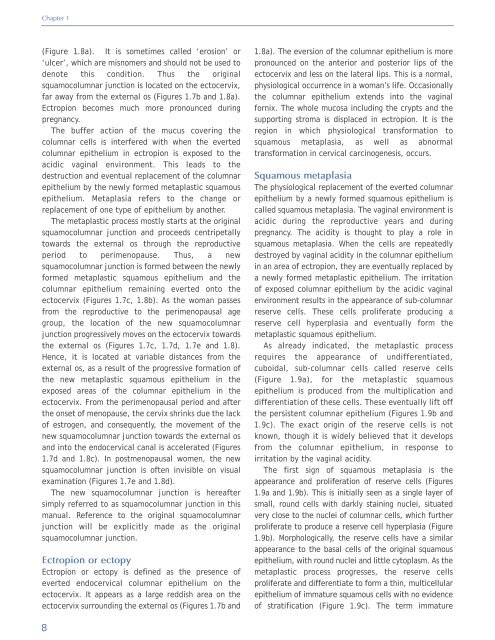Colposcopy and Treatment of Cervical Intraepithelial Neoplasia - RHO
Colposcopy and Treatment of Cervical Intraepithelial Neoplasia - RHO
Colposcopy and Treatment of Cervical Intraepithelial Neoplasia - RHO
Create successful ePaper yourself
Turn your PDF publications into a flip-book with our unique Google optimized e-Paper software.
Chapter 1<br />
(Figure 1.8a). It is sometimes called ‘erosion’ or<br />
‘ulcer’, which are misnomers <strong>and</strong> should not be used to<br />
denote this condition. Thus the original<br />
squamocolumnar junction is located on the ectocervix,<br />
far away from the external os (Figures 1.7b <strong>and</strong> 1.8a).<br />
Ectropion becomes much more pronounced during<br />
pregnancy.<br />
The buffer action <strong>of</strong> the mucus covering the<br />
columnar cells is interfered with when the everted<br />
columnar epithelium in ectropion is exposed to the<br />
acidic vaginal environment. This leads to the<br />
destruction <strong>and</strong> eventual replacement <strong>of</strong> the columnar<br />
epithelium by the newly formed metaplastic squamous<br />
epithelium. Metaplasia refers to the change or<br />
replacement <strong>of</strong> one type <strong>of</strong> epithelium by another.<br />
The metaplastic process mostly starts at the original<br />
squamocolumnar junction <strong>and</strong> proceeds centripetally<br />
towards the external os through the reproductive<br />
period to perimenopause. Thus, a new<br />
squamocolumnar junction is formed between the newly<br />
formed metaplastic squamous epithelium <strong>and</strong> the<br />
columnar epithelium remaining everted onto the<br />
ectocervix (Figures 1.7c, 1.8b). As the woman passes<br />
from the reproductive to the perimenopausal age<br />
group, the location <strong>of</strong> the new squamocolumnar<br />
junction progressively moves on the ectocervix towards<br />
the external os (Figures 1.7c, 1.7d, 1.7e <strong>and</strong> 1.8).<br />
Hence, it is located at variable distances from the<br />
external os, as a result <strong>of</strong> the progressive formation <strong>of</strong><br />
the new metaplastic squamous epithelium in the<br />
exposed areas <strong>of</strong> the columnar epithelium in the<br />
ectocervix. From the perimenopausal period <strong>and</strong> after<br />
the onset <strong>of</strong> menopause, the cervix shrinks due the lack<br />
<strong>of</strong> estrogen, <strong>and</strong> consequently, the movement <strong>of</strong> the<br />
new squamocolumnar junction towards the external os<br />
<strong>and</strong> into the endocervical canal is accelerated (Figures<br />
1.7d <strong>and</strong> 1.8c). In postmenopausal women, the new<br />
squamocolumnar junction is <strong>of</strong>ten invisible on visual<br />
examination (Figures 1.7e <strong>and</strong> 1.8d).<br />
The new squamocolumnar junction is hereafter<br />
simply referred to as squamocolumnar junction in this<br />
manual. Reference to the original squamocolumnar<br />
junction will be explicitly made as the original<br />
squamocolumnar junction.<br />
Ectropion or ectopy<br />
Ectropion or ectopy is defined as the presence <strong>of</strong><br />
everted endocervical columnar epithelium on the<br />
ectocervix. It appears as a large reddish area on the<br />
ectocervix surrounding the external os (Figures 1.7b <strong>and</strong><br />
1.8a). The eversion <strong>of</strong> the columnar epithelium is more<br />
pronounced on the anterior <strong>and</strong> posterior lips <strong>of</strong> the<br />
ectocervix <strong>and</strong> less on the lateral lips. This is a normal,<br />
physiological occurrence in a woman’s life. Occasionally<br />
the columnar epithelium extends into the vaginal<br />
fornix. The whole mucosa including the crypts <strong>and</strong> the<br />
supporting stroma is displaced in ectropion. It is the<br />
region in which physiological transformation to<br />
squamous metaplasia, as well as abnormal<br />
transformation in cervical carcinogenesis, occurs.<br />
Squamous metaplasia<br />
The physiological replacement <strong>of</strong> the everted columnar<br />
epithelium by a newly formed squamous epithelium is<br />
called squamous metaplasia. The vaginal environment is<br />
acidic during the reproductive years <strong>and</strong> during<br />
pregnancy. The acidity is thought to play a role in<br />
squamous metaplasia. When the cells are repeatedly<br />
destroyed by vaginal acidity in the columnar epithelium<br />
in an area <strong>of</strong> ectropion, they are eventually replaced by<br />
a newly formed metaplastic epithelium. The irritation<br />
<strong>of</strong> exposed columnar epithelium by the acidic vaginal<br />
environment results in the appearance <strong>of</strong> sub-columnar<br />
reserve cells. These cells proliferate producing a<br />
reserve cell hyperplasia <strong>and</strong> eventually form the<br />
metaplastic squamous epithelium.<br />
As already indicated, the metaplastic process<br />
requires the appearance <strong>of</strong> undifferentiated,<br />
cuboidal, sub-columnar cells called reserve cells<br />
(Figure 1.9a), for the metaplastic squamous<br />
epithelium is produced from the multiplication <strong>and</strong><br />
differentiation <strong>of</strong> these cells. These eventually lift <strong>of</strong>f<br />
the persistent columnar epithelium (Figures 1.9b <strong>and</strong><br />
1.9c). The exact origin <strong>of</strong> the reserve cells is not<br />
known, though it is widely believed that it develops<br />
from the columnar epithelium, in response to<br />
irritation by the vaginal acidity.<br />
The first sign <strong>of</strong> squamous metaplasia is the<br />
appearance <strong>and</strong> proliferation <strong>of</strong> reserve cells (Figures<br />
1.9a <strong>and</strong> 1.9b). This is initially seen as a single layer <strong>of</strong><br />
small, round cells with darkly staining nuclei, situated<br />
very close to the nuclei <strong>of</strong> columnar cells, which further<br />
proliferate to produce a reserve cell hyperplasia (Figure<br />
1.9b). Morphologically, the reserve cells have a similar<br />
appearance to the basal cells <strong>of</strong> the original squamous<br />
epithelium, with round nuclei <strong>and</strong> little cytoplasm. As the<br />
metaplastic process progresses, the reserve cells<br />
proliferate <strong>and</strong> differentiate to form a thin, multicellular<br />
epithelium <strong>of</strong> immature squamous cells with no evidence<br />
<strong>of</strong> stratification (Figure 1.9c). The term immature<br />
8
















